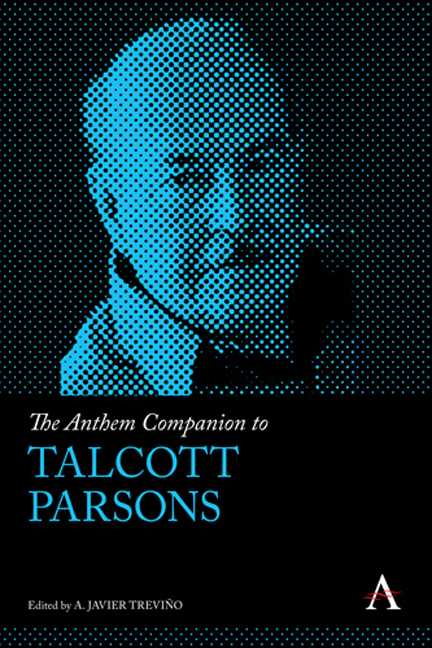Book contents
- Frontmatter
- Content
- Introduction
- Part I Political and Humanist Concerns
- Chapter One Fighting the Deadly Enemy of Democracy: Sociology against National Socialism
- Chapter Two Parsons's Critique of the Power Elite Thesis: Foundations for a Comprehensive Theory of Power
- Chapter Three The Expressive Revolution and the University: Parsons vs. Gouldner
- Chapter Four Parsons, Psychoanalysis and the Therapeutic Relationship
- Chapter Five Meanings of Life and Death: Insights of the Human Condition Paradigm
- Chapter Six Luhmann's Reception of Parsons
- Part II Social Evolution and the American Societal Community
- Contributors
- Index
Chapter Five - Meanings of Life and Death: Insights of the Human Condition Paradigm
from Part I - Political and Humanist Concerns
Published online by Cambridge University Press: 22 July 2017
- Frontmatter
- Content
- Introduction
- Part I Political and Humanist Concerns
- Chapter One Fighting the Deadly Enemy of Democracy: Sociology against National Socialism
- Chapter Two Parsons's Critique of the Power Elite Thesis: Foundations for a Comprehensive Theory of Power
- Chapter Three The Expressive Revolution and the University: Parsons vs. Gouldner
- Chapter Four Parsons, Psychoanalysis and the Therapeutic Relationship
- Chapter Five Meanings of Life and Death: Insights of the Human Condition Paradigm
- Chapter Six Luhmann's Reception of Parsons
- Part II Social Evolution and the American Societal Community
- Contributors
- Index
Summary
The days of our years are threescore and ten; and if by reason of strength they be fourscore years, yet is their strength labor and sorrow; for it is soon cut off, and we fly away.
—Psalm 90:10Throughout his career, Talcott Parsons emphasized the analytical character of the theory of social action that he consistently sought to develop. Although the theory went through several major phases of development, Parsons argued at every phase that its epistemological status was grounded in the analytical realism of Alfred North Whitehead. The theory addressed the reality of social life but only analytically abstracted aspects of that reality. The basic conceptual scheme that Parsons called the action frame of reference established the modalities of abstraction from reality within which the theory was developed. In his early work, culminating in The Structure of Social Action, the categories of ends, means, norms, conditions and, in some formulations, effort defined the action frame of reference. Parsons also characterized social action as voluntaristic, meaning that elements of choice and decision-making in the ways ends, means, norms and conditions are related in the conduct of individual actors are also realities. In works of the 1950s and 1960s, Parsons no longer presented the action frame of reference in such summary terms, but he continued to emphasize voluntarism, the normative regulation of choices of ends and means and the meaningfulness of processes of action. He focused development of theory on complex subsystems of action that are sustained over time, arguing that cultural systems, social systems and personality systems are organized independently of one another and yet intimately interconnected in the actual flow of processes of social action. When he reorganized his thinking about these major subsystems of action in terms of the four function paradigm—a way of conceptualizing the dimensions of organization of action systems generally—he added a fourth subsystem, the definition of which changed over time, but is best thought of in terms of George Herbert Mead's concept of mind. In the last several years of his life, Parsons gave new attention to aspects of reality that fall outside the action frame of reference and their relationships with elements of action systems.
- Type
- Chapter
- Information
- The Anthem Companion to Talcott Parsons , pp. 91 - 112Publisher: Anthem PressPrint publication year: 2016



